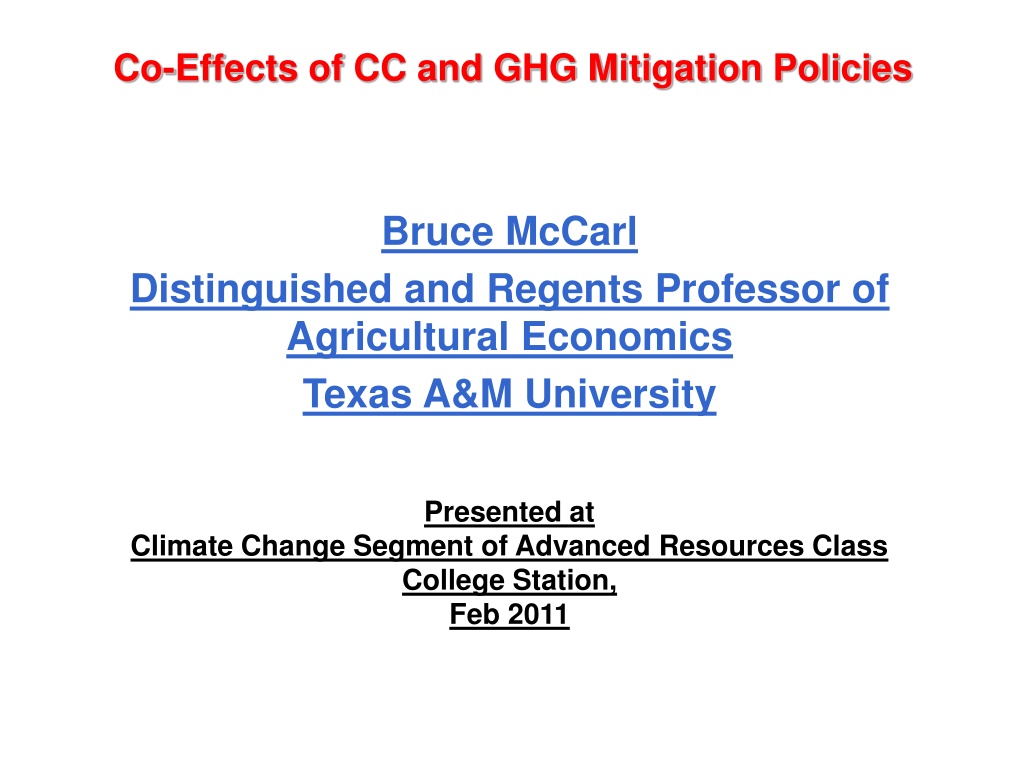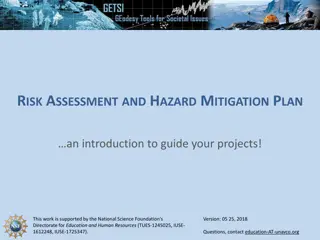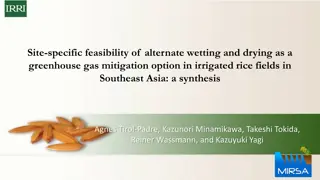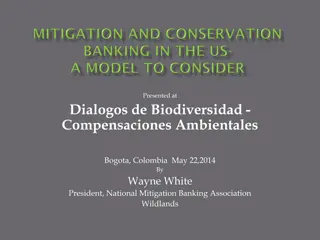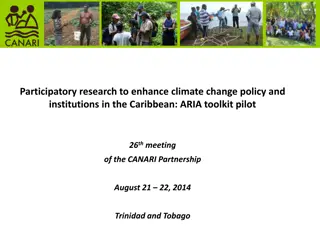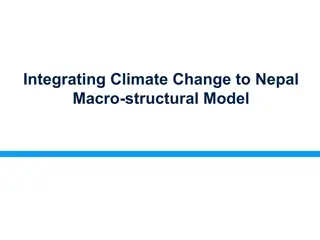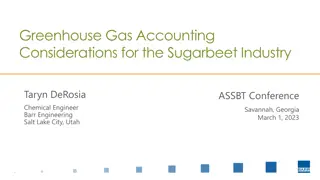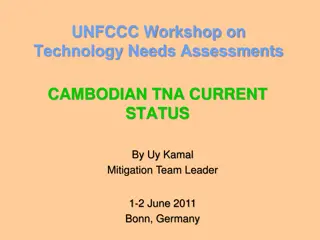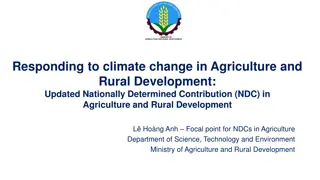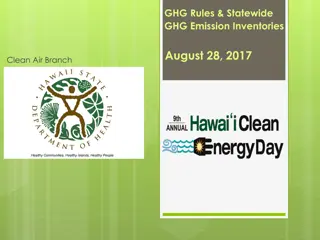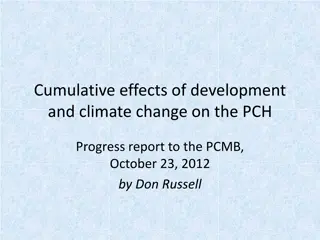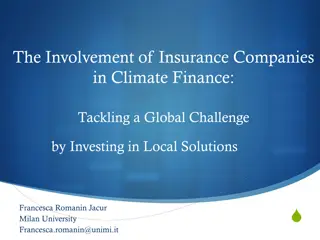Understanding Co-Effects of Climate Change and GHG Mitigation Policies
Explore the interplay between climate change and greenhouse gas mitigation policies, including their economic perspectives, measurement methods, and government interventions. Discover how these policies generate externalities and impact various sectors such as agriculture, forestry, and energy. Dive into case studies examining co-effects on water quality, soil erosion, wildlife habitat, and biodiversity.
Download Presentation

Please find below an Image/Link to download the presentation.
The content on the website is provided AS IS for your information and personal use only. It may not be sold, licensed, or shared on other websites without obtaining consent from the author. Download presentation by click this link. If you encounter any issues during the download, it is possible that the publisher has removed the file from their server.
E N D
Presentation Transcript
Co-Effects of CC and GHG Mitigation Policies Bruce McCarl Distinguished and Regents Professor of Agricultural Economics Texas A&M University Presented at Climate Change Segment of Advanced Resources Class College Station, Feb 2011
Discussion Outline What are Co-Effects of CC and GHG mitigation Policies? Do Co-Effects Matter? Ways to Measure and Quantify Co-Effects (EPIC, CENTURY, NWPCAM, Econometric techniques) Case Studies of Co-Effects e.g. water quality, soil erosion, wildlife habitat, and biodiversity Government Intervention Policy Design for Co-Effects
CO-Effects of CC and GHG Mitigation: Economic Perspective CC resulting from an increase in atmospheric concentrations of GHGEs is a public externality. Externality = Benefits or costs arise from an activity which is created by a person and that person does not take full account of the impacts on the others. Externality is a result of a market failure. A market does not efficiently allocate resources either too much or too little. GHG mitigation policies can also cause externalities. Example of externalities related to CC policies e.g. a tax on carbon in the energy sector Positive Negative Human health improvement Endangered species, etc. High energy prices Unemployment, etc.
CO-Effects of CC Policies: Economic Perspective Example of externalities and other effects related to GHG mitigation policies e.g. a tax on carbon in the agricultural and forestry sectors Positive Negative Water quality improvement High food prices Less erosions, etc. More pesticide use, etc. Many terminologies are used to describe CO-EFFECTS which refers to effects arising from GHG mitigation polices such as co- benefits/costs, income distributional shifts, ancillary benefits/costs, side-benefits, secondary benefits/costs, cleaner water, reduced runoff, increases across GHG accounts etc. Few studies address these issues especially negative co-effects e.g. use of more pesticides or irrigation, effects on other GHGs.
Ag CO-Effects of CC Policies Framework Land Use Change Social Effects Econ Effects Environ Effects CC Effects Direct Effects CO-Effects Tech Progress Water Quality Rural Econ Air Soil Quality Job Bio- ETC. Quality Creation diversity Public Health Fuel Security Life Styles Recreational Impacts Endangered Species ?? ?? ?? ??
Do Co-Effects Matter? Previous studies indicate that there are significant CO-Effects associated with GHGE mitigation, but most of the studies focus on positive CO-Effects (co-benefits). Figure 8.9: Summary of ancillary benefits estimates in 1996 US$/tC. Source: Climate Change 2001: Working Group III: Mitigation http://www.grida.no/climate/ipcc_tar/wg3/337.htm
Do Co-Effects Matter? Inclusion of CO-Effects will affect cost of reductions. Carbon Tax ($/TCE) MC + Externality Benefits MC MC + Externality Costs Tax0 Q2 Q1 Q0 Emission Reduction (tons) Figure 2. Marginal Cost Curve for Carbon Emission Reductions
Do Co-Effects Matter? Inclusion of CO-Effects will affect cost of abating of emissions and quantity. At market equilibrium, society would produce Q* at P*. If there are externality benefits, society produces too little energy (Q* < Q1) with too high price (P* > P1). If there are externality costs, society produces too much energy (Q* > Q2) with too little price (P* < P2). SMC = MCprivate + Externality Costs $ MCprivate SMB P2 P* P1 Q1 Q2 Q* Energy Figure 1. Social Marginal Benefit and Marginal Cost Curve for Energy
Do Co-Effects Matter? Inclusion of CO-Effects will affect overall mitigation assessment. The social optimal output is at the quantity where SOCIAL BENEFITS = SOCIAL COSTS SOCIAL COSTS = PRIVATE COST - EXTERNALITY BENEFITS/COSTS Problem: how to get the accurate measures of these externalities? These externalities can over- or underestimate social welfare gain under different mitigation policies. Suppose that the social costs for 2 mitigation policies is such that SC1 > SC2 so society favors mitigation 2 But the order of the private costs is reversed PC2 > PC1 so private groups prefer mitigation 1 Numerical Example: SC1 =150 , but PC1 = 50 + Externality = 100 SC2 =100 , but PC2 = 100 + no Externality
Co-effects of Emission Reductions by Energy Sector Coal use releases sulfur dioxide, particulates, chemicals that contribute to air pollution including ozone $10 per ton carbon tax could result in $3 health benefit from associated NOx reductions (Burtraw, 1999) Approximate by using marginal costs as social willingness to pay, 15$ per ton of CO2 (EIA, 1995). 11
Measure and Quantify Co-Effects Quantitative Indicators Although some Co-Effects are not monetized, quantitative indicators are useful. Use biophysical simulation or other air/water quality simulation models such as EPIC, CENTURY, SWAT, NWPCAM EPIC Multi-environmental Indicators 100 Nitrogen Subsurface Flow 90 Pollution (%/acre) 80 Nitrogen Percolation 70 60 Soil erosion 50 Phosphorus loss through sediment 40 0 50 100 Carbon price ($/tce) 150 200 250 300
Measure and Quantify Co-Effects Monetization Development of methods to quantify Co-Effects in terms of dollar values Econometric techniques such as non-market valuation, ricardian model, etc. Would you be willing to pay __$ on an annual basis for a management program designed to preserve endangered species XX? Note that: If a policy focuses on the environmental quality and in doing so this policy affects the CC, then now the CC effects are considered Co-Effects to this policy. For example, a policy focusing on cutting air pollution also benefits the climate through reduction of GHG emissions.
Case Studies of Co-Effects: Water Quality Reference: Pattanayak et al. 2002 Ag Census NRI State Annual Crop Acreage Carbon Prices Regional Crop Mix input use Env loads County Crop Mix and percent loads Water Quality Index NWPCAM ASMGHG Regionalizing Model EPIC Runoff Sim. Run ASMGHG at GHG prices of $25, and $50/tonne CE Link NWPCAM to ASMGHG outputs Run NWPCAM at elevated loadings corresponding to 2 GHG prices ($25 and $50) Estimate WQI at two levels Compute = 14
Case Studies of Co-Effects: Water Quality Overall Results: Economic Agricultural production declines (2-4%) and prices increase (3-8%) CS decreases, PS increases, Export earnings fall (3 5%). GHG (not co-effects) National GHG emissions decline (89 and 156 MMTCE/yr under $25 and $50 /ton CE, respectively). Agriculture becomes a net sink at high GHG price. Low C price=> Low/no till cropland management High C price => Biofuel offsets and afforestation Land use Traditionally cropped lands decline(0.1 6%) Irrigated lands decline(3 7 %) Afforestation increases(5 12 million acres) 15
Co-Benefits: Water Quality Changes due to Changes in Cropland Management and Afforestation Preliminary Results, at $25/tC Change in WQI from Baseline -40 to -1 0 1 to 5 6 to 100 16 Source: Pattanayak et al. 2002
Case Studies of Co-Effects: Water Quality Overall Results: Loadings N and P decline at low price All loadings decline at high price Erosion reductions most dramatic National WQ increased nearly 2% Future Extensions: Co-effects Monetized Multiple co-effects biodiversity Omitted loadings in forestry and livestock 17
Case Studies of Co-Effects: Environmental benefits Reference: Plantinga and Wu 2003 Empirical Procedure Landik = fik (net return, population density, land quality ) fik = logistic function using SUR procedure Net return to forest=> + effect on the forest but on the agriculture Net return to Ag => effect on the forest but + on the agriculture Estimate Land Use Five values of subsidies are used to achieve conversion of 5%, 10%, 15%, 20%, and 25% of the baseline ag land. Average costs for afforestation rise from $200 (5% conversion) to $600 per acre (25% conversion). Get Acres of Afforested Land Using Birdsey forest carbon function to estimate additional C seq. through afforestation. Using the Natural Resource Inventory (NRI) and the Soil Interpretation Record System (SOILS5) to predict locations, agricultural land conversion, and environmental characteristics (e.g. soil type, permeability). Determine C Seq.& Environ. Characteristics Using estimation from previous studies to quantify environmental benefits. Under 25% conversion scenario => soil erosion benefits = 32-42% of cost of Cseq. program => wildlife habitat benefits = 25% of cost of Cseq. program => non-consumptive use benefits =25% of cost of Cseq. program Estimate Environ. Benefits
Case Studies of Co-Effects: Environmental benefits Remarks: (1). Co-Benefits appear to be substantial. Soil erosion + Wildlife habitat (Use Value) +Non-Use Value $42 M + $30 M (under 25% conversion scenario) Cseq Cost $101-132M + $31 M (2). The number of potential co-benefits and co-costs are not included (e.g. water quality improvement, negative effects on wildlife habitat). (3). Unrealistic fixed prices assumption on timber and agricultural products
Case Studies of Co-Effects: Biodiversity Category Maine South Carolina Wisconsin Percent Change 2.5 Forest Birds 3.2 21.8 Farmland Birds -10.8 -12.2 -11.7 Forest & Farmland Birds -2.0 -2.3 -1.1 Reference: Matthews, O Connor, and Plantinga 2002 Study of land use changes impacts on biodiversity in South Carolina, Maine, and Southern Wisconsin Two types of land use => agricultural and Forestry lands Two types of birds => farmland and forest birds (651 species) Using an econometric model to estimate land use changes due to afforestation subsidies Achieving a 10% reduction in agricultural land by giving afforestation subsidies as an incentive Using an estimated land use change to estimate bird abundance
Negative the net Co-benefits (CB) + + + PDC ( PAIC MTC * GC CB ) = Social cost per ton QGHGO 1 ( * DISC ) Some co-effects are beneficial and can help offset the costs of producing practices from a social perspective eg: Improving water quality from low tillage eg.: Enhancing producer incomes from conversion of cropland to grasslands The co-benefits likely to be partially offset by co-costs Expanded emissions in the energy sector vs. the offsets gained from CS Co-effect are relevant in all sectors of the economy accounting needs to be evenhanded Reference: McCarl.B.A , Tanveer A. B , Man,K. Kim, Cost of Carbon 21
Examples about potential ancillary benefits or costs Particle pollution fossil fuel use Recreational sites reforestation programs Technological efficiency new technologies and unit costs fall Welfare carbon taxation Road-use related mortality public transport Congestion public transport Employment GHG projects with excess supply of labor Higher electricity prices reductions in electricity reduce educational opportunities for children Reduced electrification rates increases in household air pollution Costs associated with ghg projects decreased economic activity decline in employment 22
Co-effects from Agriculture and Forestry Sequestration Watson 2000: co-benefits soil productivity could be improved through increased capacity to retain water and nutrients long-lived valuable products (wood) are produced marginal lands could be improved and riparian ecosystems restored Erosion reduction Antle 2000 Reduced erosion, improved land quality, water quality, recreation sites, bio-diversity, farmer income support . 23
AM: Assessed in monetary terms AP: Assessed in physical terms, possibly partly in monetary terms. NA: Not assessed, they may be important. NE: No effect of significance is anticipated. 1. SO2 and NOx include acid deposition impacts. 2. Effects of PM10, NOx and SO2 on amenity arise with respect to visibility. In previous studies these have not been found to be significance in Europe, although they are important in the US. 3. Routine operations generate externalities through mining accidents, transport accidents, power generation accidents, construction and dismantling accidents and occupation health impacts. All these involve mortality and morbidity effects. 4. Water pollution effects include impacts of mining (including solid wastes) on ground and surface water, power plant emissions to water bodies, acid deposition and its impacts on lakes and rivers (partly quantified). 24
Co-effects consider or not? Consideration could speed up implementation High cost of climate change mitigation might be largely offset by ancillary benefits Policy benefits of incorporating co-effects Design policy on inclusive set of effects Support GHG initiatives with broader environmental co-effects ( no regrets ) Justify interventions in favor of terrestrial activities Safely ignored If these effects are small relative to the other costs or the benefits of reducing GHGs Simplifies an already complex debate. 25
Co-effects GHGE Mitigation Co-effects Transportation Agricultural Involvement Mitigation in Energy Sector Co-effects Co-effects Co-effects 26
Ag vs Non Ag share of a given amount of emissions control CN CA All Non-ag All ag Q CA is cost of abatement by Ag, CN is cost of abatement by Non Ag, 27
Ag vs Non Ag share of a given amount of emissions control CN CA C A Ag cobenefits All Non-ag All ag Q Q Ag co benefits only and ag share increases 28
Ag vs Non Ag share of a given amount of emissions control CN CA C A C N Non Ag cobenefits Ag cobenefits All Non-ag Q All ag Q Q Ag and non ag co benefits and share depends on relative size 29
Case Studies of Co-Effects: Environmental benefits Remarks: (1). Co-Benefits appear to be substantial. Soil erosion + Wildlife habitat (Use Value) +Non-Use Value $42 M + $30 M (under 25% conversion scenario) Cseq Cost $101-132M + $31 M (2). The number of potential co-benefits and co-costs are not included (e.g. water quality improvement, negative effects on wildlife habitat). (3). Unrealistic fixed prices assumption on timber and agricultural products 30
Challenge Complexity => multiple co-effects, double count, global vs. local effects, etc. Air Quality CC Human Health Mitigation Water Quality Quantifiability => methodologies Policy Design Distributional effects => CDM Uncertainty
Reference Antle J.M., Economic Feasibility of Using Carbon Sequestration Policies and Markets to Alleviate Poverty and Enhance Sustainability of the World s Poorest Farmers , Presened at the Expert Workshop on Carbon Sequestration, Sustainable Agriculture and Poverty Alleviation, World Meteorological Organization, Geneva Switzerland, August 31, 2000 Antle, J.M. and S. Mooney. 2002. Designing Efficient Policies for Agricultural Soil Carbon Sequestration. Chapter in Agriculture Practices and Policies for Carbon Sequestration in Soil, edited by J. Kimble, CRC Press LLC, Boca Raton, FL, pp. 323-336 Burtraw, D., Innovation Under the Tradable Sulfur Dioxide Emission Permits Program in the U.S Electricity Sector. Resources for the Future Discussion Paper No. 00-38, 2000. Burtraw, D. Krupnick, A., Palmer K.,Pul, A., Toman M., Bloyd, C., Ancillary Benefits of Reduced Air Pollution in the U.S. from Moderate Greenhouse Gas Mitigation Policies in the Electricity Sector . Resources for the Future. Discussion paper No. 99-51. 1999. Elbakidze, L., and B.A. McCarl, "Sequestration Offsets versus Direct Emission Reductions: Consideration of Environmental Co-effects", Ecological Economics, Volume 60, 564-571, 2007. Energy Information Administration, Electricity Generation and Environmental Externalities: Case Studies, Office of coal nuclear and Alternative Fuels, Coal and Electric Analysis Branch, U.S. Department of Energy, Washington D.C. 20585, 1995. International Panel on Climate Change, Climate Change 2001: The Scientific Basis . IPCC Third Assessment Report. 2001. http://www.ipcc.ch/ Matthews, S., O Connor, R., and A., J., Plantinga. Quantifying the Impacts on Biodiversity of Policies for Carbon Sequestration in Forests. Ecological Economics. 40(1): 71-87. 2002. Krupnick A., Dallas B. and Anil M. The Ancillary Benefits And Costs Of Climate Change Mitigation: A Conceptual Framework http://www.airimpacts.org/documents/local/M00007466.pdf McCarl, B.A. and U.Schneider, (2000). Agriculture's Role in a Greenhouse Gas Emission Mitigation World: An Economic Perspective . Review of Agricultural Economics 22:134-159. 32
Reference McCarl.B.A , Tanveer A. B , Man,K. Kim How much would Carbon Cost a Buyer? Working Paper 2004 McCarl, B. A., B. Murray, and J. Antle, Agricultural Soil Carbon Sequestration: Economic Issues and Research Needs . Working Paper #0875, Department of Agricultural Economic, Texas A&M University, College Station, TX Meyer, J. L.,M. J. Sale, P. J. Mulholland,and N. L. Poff, Impacts of climate change on aquatic ecosystem functioning and health Journal of the American Water Resources Association, 35(6), pp.1373-1386,1999. National Assessment Synthesis Team Climate Change Impacts on the United States:The Potential Consequences of Climate Variability and Change US Global Change Research Program,400 Virginia Avenue,SW Suite 750 Washington DC,20024 www.usgcrp.gov Pattanayak, S.K., B.A. McCarl, A.J. Sommer, B.C. Murray, T. Bondelid, D. Gillig, and B. de Angelo, "Water Quality Co-effects of Greenhouse Gas Mitigation in US Agriculture", Climatic Change, 71, 341-372, 2005. Plantinga, A. J., Modeling the Impacts of Forest Carbon Sequestration on Biodiversity. Department of Agricultural and Resource Economics, Oregon State University. Plantinga A. J., and J. Wu, Co-Benefits from Carbon Sequestration in Forests: Evaluating Reductions in Agricultural Externalities from and Afforestation Policy in Wisconsin. Land Economics, 79(1), 74-85, 2003 Stavins, R.N., "Transaction Costs and Tradable Permits", Journal of Environmental Economics and Management, 29:133-148,1995. Watson, R.T., report to the Sixth Conference of the Parties of the United Nations Framework Convention on Climate Change , IPCC, http://www.ipcc.ch/press/speech.htm Nov.13, 2000 Watson, R.T. and the Core Writing Team (Eds.), IPCC Third Assessment Report: Climate Change 2001: Synthesis Report, IPCC, Geneva, Switzerland, September 2001. http://www.ipcc.ch/pub/un/syreng/spm.pdf Wietzman, M., L., Prices vs. Quantities Review of Economic Studies. 41 (4): 447-91, 1974 33
